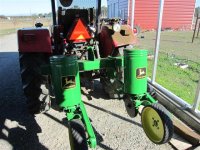For food plots, a 2-row planter is best (unless your plots are over 10 acres or so acres, when a 4-row would be better). With the 2-row, you can often get more corn, very easily, into tighter spots. For this reason, 2-row planters usually sell for more money at auctions, than 4-rows. This is due to their much higher demand. 4-row planters are too small for "real farmers", and to big for food-plotters/gardeners. They can be a real bargain however, for folks handy in metal fabrication, as many, like the JD 71, can be easily split into (2) 2 row planters.
Personally, I don't like the JD 71's, because they rarely contain fertilizer attachments. Yes, there are some folks who try and pass off insecticide attachments as "fertilizer". You will know you are being duped if the "fertilizer" hopper is smaller than the seed hopper. An insecticide applicator lacks both the capacity and the corrosion resistance to be used for fertilizer.
You can usually find an older planter, like a JD 246 (3-pt),/290 (pull type) or similar models by IH, MF, Ford, AC, with working fertilizer attachments, for less money than a JD 71 without. Those JD's use the same plates as the 71's and they are widely available. My JD 246 has been very dependable, over the 20 years I have owned it. Burying the fertilizer, only by the rows, has saved me many hundred dollars thru the years, compared to if I had broadcasted and hoped for a rain.
As far as hp goes, that don't come into play here, unless we are talking about a no-till planter. Even a medium sided ATV has plenty for a pull-type, like a JD 290. Your compact tractor could easily handle a 4 row, unless, if it was a 3-pt and the fertilizer hoppers were all filled to the top. Then you would need to add some
ballast up front (iron weights or calcium filled tires). If it was no-till, you would be limited to a 2-row. I have never used, and know nothing about them.



